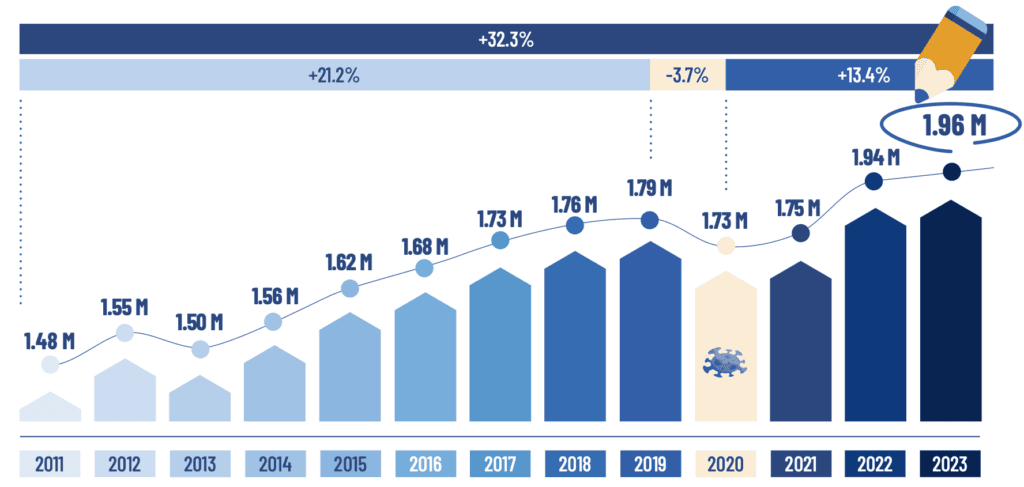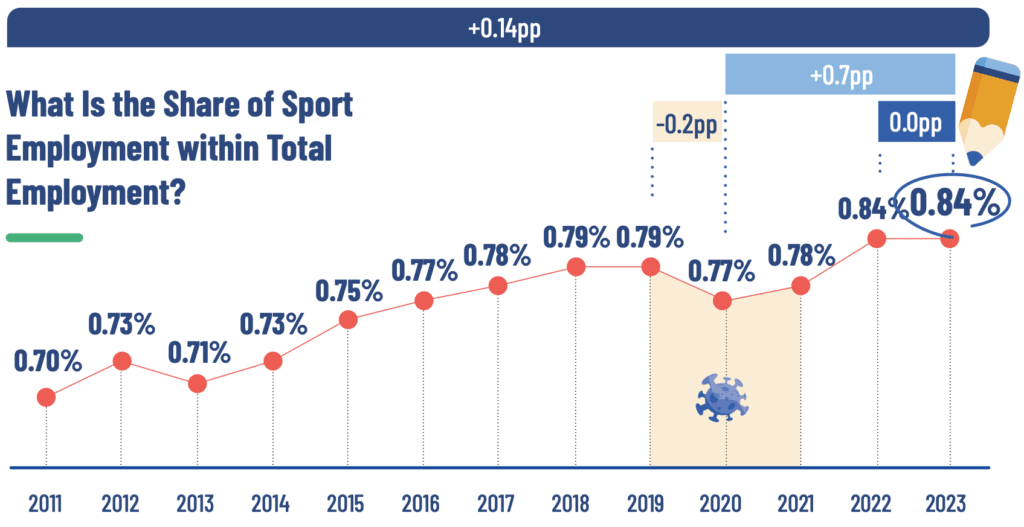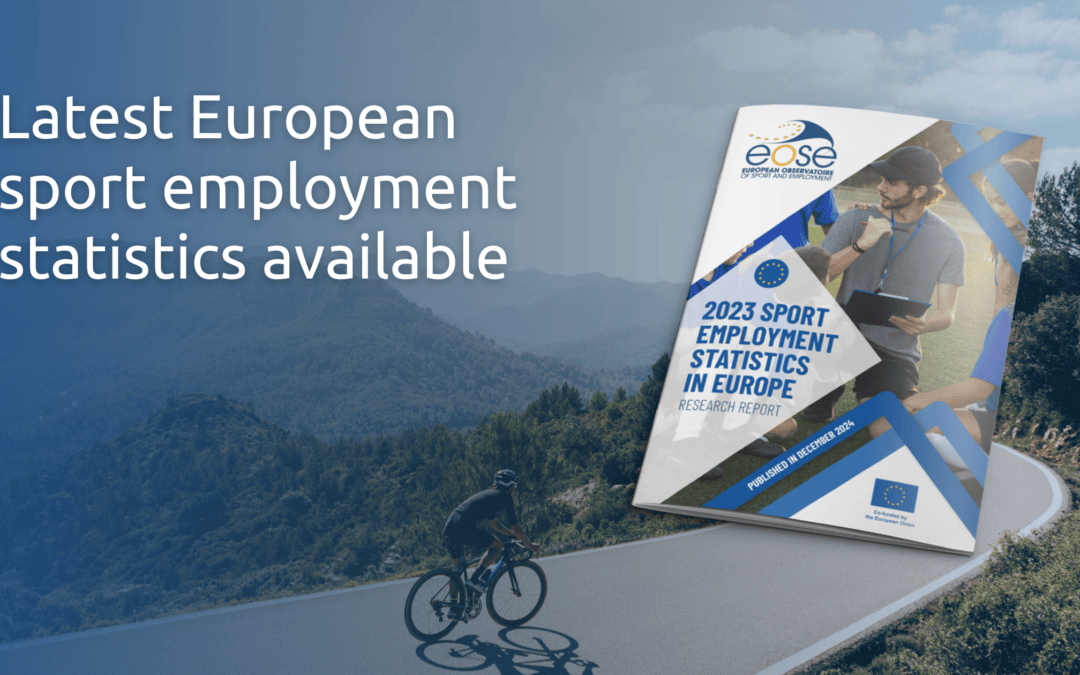EOSE collates, analyses and publishes the latest sport employment statistics on an annual basis to share and underline main characteristics and tendencies, and to encourage consultation and help create policy discussions, concrete impact and potential collaborations through the sector.
We are pleased to present you with the latest European and national reports and fact sheets covering the period from 2011 to 2023 included.
Within the documents readers can find:
- Detailed analysis of the European paid employment statistics in the Research Report entitled 2023 Sport Employment Statistics in Europe, including long-term trends and data on the total numbers, share and characteristics of people employed in the sport sector (gender, age, employed/self-employed status, full/part-time contracts, level of education) compared to all economic sectors combined
- Short and easy to understand Fact Sheets including visual infographics on the main data points and characteristics both for Europe (EU27 countries + UK) and for each of the 28 analysed countries in individual National Fact Sheets
- Within each document, an analysis of the whole sector, as well as a separate focus on workers with a sport and fitness occupation (e.g. coaches, instructors, athletes etc.), and people working in sport organisations
Changes and additions compared to last year:
- New, simplified and easy to understand design of the European Fact Sheet
- New data available – a cross-tabulation of the employed/self-employed status and full/part-time contracts by workers’ ages and genders
Access the documents through the link below, promote the publication with your network, and read on for a summary of findings.
KEY 2023 SPORT EMPLOYMENT FINDINGS AND TRENDS AT THE EUROPEAN LEVEL
How many people work in the sector?

Sport employment in the EU+UK – the sum of workers with a sport and fitness occupation and all people working in sport organisations, both employed and self-employed – now represents 1 958 467 workers and this grew by +32.3% from 2011 to 2023.
In 2023, the following 5 countries with the largest sport employment represented 69.2% of the total number of workers in the sector:
- The UK represented 21.4%
- France – 14.7%
- Spain – 12.5%
- Germany – 12.2%
- Italy – 8.3%
How has the sector dealt with the COVID pandemic?
Looking at the impact of the COVID pandemic on total sport employment, following a drop of -3.7% in total employment from 2019 to 2020, the sector recovered by +13.4% by 2023. However, there are disparities between countries. The sector, in terms of total sport employment, seems to have recovered to pre-COVID numbers in 18 countries, but is still below the 2019 levels in 10 others. By 2023, two of the countries with the highest number of people employed in sport had still not returned to 2019 numbers – UK (-2%) and Germany (-8.8%).
What is the share of Sport Employment within Total Employment (all economic sectors)?

The sport sector is taking up a growing share of total employment in all economic sectors – in 2023 it represented 0.84% of the total. Since 2011 there was a growth of about +0.14 percentage points over 12 years, suggesting that sport employment had become increasingly significant in overall economy during this period.
The share of sport employment in total national labour force (all sectors) ranges widely across countries – in 2023, the highest share could be seen in Sweden (1.4%), Denmark (1.31%), UK (1.27%), the lowest – in Romania, Bulgaria, Slovakia (between 0.28-0.39%).
Characteristics of sport employment
Through our analysis we aim to highlight realities, characteristics and tendencies of sport employment by gender, age, level of education, type of working contract (full-time or part-time) and professional status (employed or self-employed) of people working in the sector.

Gender

In terms of gender, the workforce in the sport sector remains male-dominated, with 55% of male versus 45% of female workers. The proportion of female workers in 2023 has declined from 45.7% in 2022 and 47.9% in 2011, when data collection began. It also remains below the share of female in total employment across all sectors, which was at 46.7% in 2023. The proportion varies across European countries – the proportion of female workers per country is shown in the map below:
Age

Age-wise, there has been a significant increase in the proportion of young workers under the age of 25 in the sport sector, reaching 25.9% in 2023 – 3 percentage points higher than in 2011. A recent rise is also observed among workers with low qualification levels, increasing by 0.9 percentage points since 2020. Compared to the overall employment in all sectors, the sport sector employs a lower proportion of workers aged 50 and above (24.2% versus 32.8%). Over the past 12 years, people employed in sport had become better qualified, with the proportion of sport workers with high level qualifications growing from 28% in 2011 to 39% in 2023.
The map below shows the high variance of the proportion of young staff in the workforce – of particular note are Nordic countries with the proportion reaching over 40%.
Type of contract

Regarding the types of contracts, in 2023, the majority of people employed in the sport sector were on full-time contracts (56.8%), while 43.2% worked part-time. This represents a significantly higher proportion of part-time workers compared to the EU average across all economic sectors (18.9%). For female workers in sport, the share of part-time contracts is even higher, with 50% of women being employed on a part-time contract. The proportion of part-timers also vary widely across nations as shown on the map:
Professional status

In terms of professional status, compared to workers in all economic sectors, sport workers are significantly more likely to be self-employed, with 22.2% of sport workers being self-employed, compared to 13.1% across all sectors. The proportion of self-employed workers in sport has increased by 4.3 percentage points since 2011. Additionally, more than half of all self-employed workers in sport were over the age of 40 years (54.9%).
EUROPEAN RESEARCH REPORT AND FACT SHEET
NATIONAL FACT SHEETS

2023 Sport Employment Statistics: National Fact Sheets
Click button to download national fact sheet


